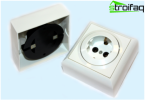Dimmer for various types of lamps
Each of us wants to make our home the best. This is not surprising, because it is at home that we rest from the hustle and bustle of success, it is here that we can calmly chat with our close or good friends. But zealous owners care not only about the beauty of the interior. And here scientific and technological progress comes to our aid, which makes it possible to combine comfort and economy. Here, for example, a dimmer dimmer – by putting it instead of a conventional switch, you can adjust the brightness of the lighting in the apartment, saving up to 50% of electricity.
Content
- Dimmer switch – what is it?
- Classification of dimmers
- Depending on the type of lamp
- Division by body type
- Criterion – Management Method
Dimmer switch – what is it?
What is a dimmer? The word itself was formed from English to dim, which in translation into Russian means “darken”, and since people in our country love words of foreign origin, it has taken root. Indeed, the “dimmer” sounds more mysterious than just a “dimmer”, and even shorter. In general, a dimmer controls the electrical power of the load and can be used not only for lamps, but also for other technical devices, such as an iron or a soldering iron. However, this novelty gained the most popularity in the lighting settings..
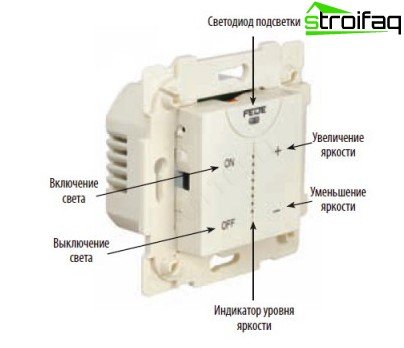
Dimmer or dimmer
The dimmer can be used as a regular switch (if it is configured for maximum brightness), but basically a dimmer is used to vary the brightness of the fixtures. At low voltage, the lighting turns out to be soft, not cutting eyes, which is very convenient if you have to get up at night to the child or leave light in the corridor for households who return late. The maximum voltage gives a bright light, at which you can receive guests or read.
Intermediate brightness transitions can be set for various tasks, for example, when watching television programs it is not necessary at all that the lamps burn at maximum brightness, on the contrary, it can even interfere. But if you need to do homework or want to play board games (say, pick up puzzles) it is better that the light is bright enough. It is also convenient to control the transition from daylight to twilight by a dimmer, when the brightness of artificial lighting should be increased gradually.
Classification of dimmers
Depending on the type of lamp
Dimmers are not the same, for example, they are different for different types of lamps:
- dimmer for incandescent bulbs (using a normal voltage of 220 V)
- dimmer for halogen lamps (two types: used at a voltage of 220 V and in the voltage range from 10 to 24 V)
- dimmer for LEDs and fluorescent lamps
- dimmer for energy-saving lamps (not for all types)
In order not to make a mistake in choosing the right dimmer, carefully select lamps for fixtures, especially energy-saving ones – only a few of these lamps support dimming. On fluorescent and energy-saving lamps that allow the use of a dimmer, there are special designations (marking).
Most often, dimmers are used for conventional incandescent, halogen and LED lamps, since in these cases, the use of a dimmer in addition to convenient lighting effects also gives tangible energy savings. By the way, in addition to special (oriented to a certain type of lamps) dimmers, there are universal ones that select the necessary type of dimming themselves. However, professionals find universal dimmers less reliable..
For low-voltage halogen lamps, a step-down transformer is required. Moreover, for certain types of transformers, only certain dimmers are suitable, so when choosing a dimmer in this case, you need to be very careful. For winding transformers, use a dimmer labeled RL, for electronic ones, a dimmer marked C. Of course, there are dimmers with built-in transformers, but they are most convenient for a smart home system. In the usual case, it is much better to use a separate transformer (located near the halogen lamp) and a dimmer, which is placed quite far from the lamp. And one more little secret – if the halogen lamp constantly works at low brightness, its glass begins to darken. In this case, you should turn on the lamp at full power for at least 10 minutes, while the glass will be cleaned, and you can again reduce the brightness.
Caution should be exercised when dimming fluorescent lamps. With linear LLs, it is imperative to install an electronic ballast (ECG). But compact LLs are often already available with built-in ballasts, and ordinary dimmers for incandescent lamps are quite suitable for them. But it’s better to check whether there is a ballast in the compact fluorescent lamp or not.
Just a few years ago it was believed that a dimmer for LED lamps could not be used. But progress does not stand still, now in the market it is quite possible to find LED lamps with the possibility of dimming, and a dimmer for led strip or lamps. So everything is in your hands – LED lamps with adjustable brightness are not uncommon.
Division by body type
In addition to dividing into groups according to the type of lamp, dimmers are also distinguished by the type of housing (installation method):
- wall (monoblock)
- instrumentation (installation in a mounting box)
- panel board (modular)
Wall dimmers were designed to replace ordinary switches. That is, in principle, the dimmer has the same shape and size as the switch, and is applied in the same way..
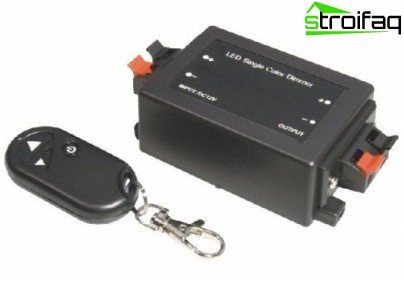
Remote control dimmer
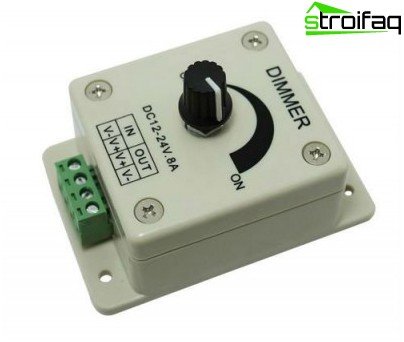
Another kind of dimmer
Instrument dimmers are installed in a mounting box or behind a suspended ceiling. In the second case, control is carried out using remote control.
And finally, modular dimmers are mounted on a DIN rail in a power switchboard. These dimmers are mainly used for lighting in the corridor or stairwell. Can be controlled by either a special remote button or remote control.
Criterion – Management Method
Since there are enough varieties of dimmers, they can be divided according to the control method, which, as a rule, refers to wall dimmers:
- rotary (rotary)
- keyboard (push)
- sensory
Rotary dimmers have a round switch, the rotation of which sets the currently required brightness of the lighting. Key dimmers are regulated by pressing a key; in touch dimmers, brightness is adjusted using the touch panel.
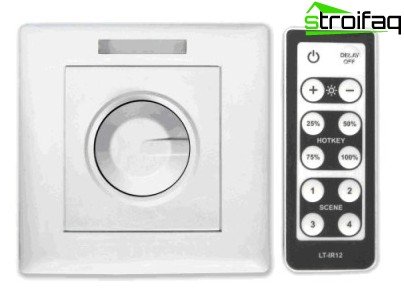
Rotary dimmer with remote control
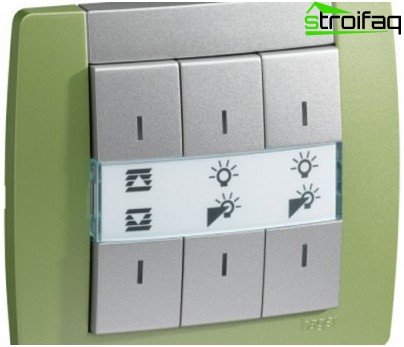
Key Dimmer
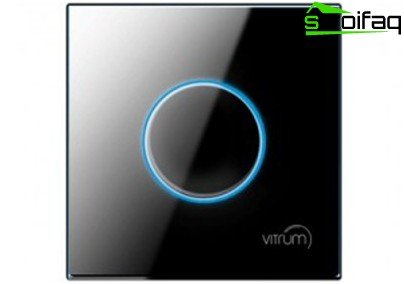
Touch Wall Dimmer
Another interesting addition to this classification will be a dimmer with a remote control – usually a dimmer with an infrared or radio-controlled remote control. Such a dimmer belongs to the category of “wireless lighting switches” and can be installed both as a wall, and as an instrument or switchboard. Those who are interested in the remote control for the dimmer should remember that the IR remote control is only effective when the dimmer is directly visible at a distance of no more than 7 meters. With radio control, it is possible to send a signal through various obstacles, even through a wall. This is very convenient if the dimmer is installed in the switchboard..
Use and installation of dimmers
When using a dimmer at home (and not only), the greatest convenience is the ability to connect to a single dimmer as one or a group of fixtures, the main thing is that they belong to the same form. That is, you can install a dimmer on the sconces in the bedroom or connect ceiling and wall lights to it in the living room or hallway. And using the remote control to adjust the brightness.
If you use dimmers in the “smart home” system, then it is quite possible to set a timer and another program that itself will make sure that the light turns on or off in time, as well as increase or decrease the brightness of the lighting.
Several installed dimmers can be combined on one remote control, and then it becomes possible to vary the brightness of the lighting of several zones at once (combined groups of luminaires). There can be from two to six such zones, thus, in one center the lamps of all rooms of a house or apartment are combined.
In addition to the usual lighting, which we have long been accustomed to, with the help of dimmers you can make the apartment’s interior more original using accent lighting of different corners of the room (when dividing a large room into several zones for various purposes, for example, the living room is often divided into a soft corner for a small company and the center where they host a large number of guests). Or they highlight the most interesting interior details – decorative illumination of paintings, indoor plants, collections and the like. Playing with light, talented designers can visually change the impression of a room depending on the time of day or an upcoming event. The same room turns out to be either a bright solemn hall for receiving guests, or a dance floor with dim lighting and color music for a youth party, or an ordinary room for family watching TV.
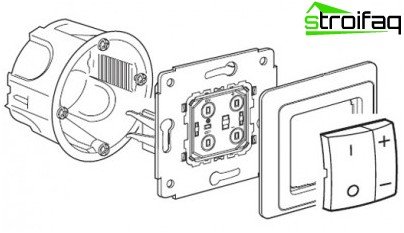
This is how the hinged key dimmer is set
So, not the most complicated device allows you to make housing more comfortable and original. In addition, you can mount the dimmer with your own hands. Especially if you already have experience installing conventional switches or sockets. The system is quite simple, you just need to follow the diagram and connect the wires correctly. However, many prefer to invite a specialist for such actions, who will certainly do everything right.
Most often, the services of professionals are used for more complex connection schemes, for example, to install a dimmer for several fixtures or to install different lighting zones. Connect a dimmer to the lighting system and enjoy the new comfort.


